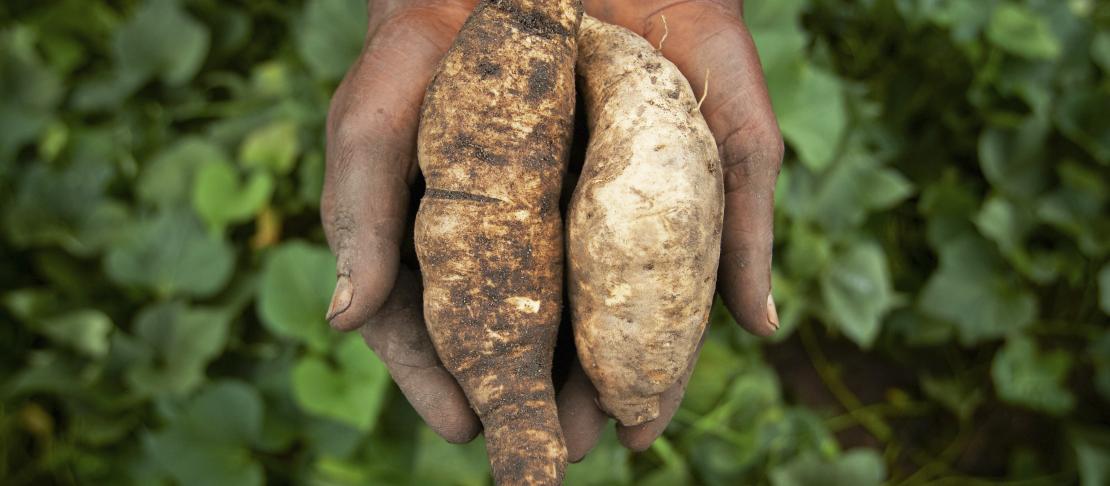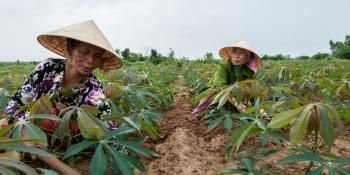Sweetpotato gives hope: ensuring climate-smart food systems, livelihoods and resilience

Sweetpotato, an underutilized, humble but very resilient tuber crop proves its value in securing food for people, especially in times of calamities such as those experienced in the Philippines.
“In the Philippines, many people do not realize how nutritious and valuable the sweetpotato is and how useful the crop is for disaster recovery, especially for the resilience of rural communities after disasters such as that brought by Typhoon Yolanda (Haiyan),” said Dr. Christopher Wheatley in a video message.
Dr. Wheatley is the Interim Project Leader of Food Security Through Asian Roots and Tubers (FoodSTART) – a project from the International Potato Center (CIP), financed by The International Fund for Agricultural Development (IFAD)
In a media seminar workshop co-organized by the CGIAR Research Program on Climate Change, Agriculture and Food Security in South East Asia (CCAFS-SEA) and the International Rice Research Institute (IRRI) from 14-15 August 2014, sweetpotato caught the attention of the participants, mostly agricultural journalists and broadcasters, in the Philippines.
Eating sweetpotato, more fun in the Philippines?
Until recently, sweetpotato, “camote” to the Filipinos, has been an undervalued crop. Some participants at the media workshop shared anecdotes related to sweetpotato. One journalist recalled that whenever he got low scores, his grade school teacher would say, “You should go home and just plant camote.” Another participant said that he associates camote with poverty. During his childhood, when they could not afford rice, they only had sweetpotato for their meals. These are common misperceptions about sweetpotato in the Philippines – the crop is “lowly” and often associated with underperforming, incompetent students and the impoverished.
Representing CIP during the media forum was Dr. Julieta Roa, a collaborating researcher of CIP-FoodSTART. She was also the former director of Philippine Root Crop Research and Training Center (PhilRootcrops), CIP’s national program partner in the Philippines. Dr. Roa enumerated several cases in the country where sweetpotato had played a crucial role in disaster recovery. CIP’s presentation gave the participants a clearer understanding of the importance and uses of sweetpotato – for both nutrition and food security.
Sweetpotato takes center stage in disaster situations
As the other PMCA/MarketLink pilot area, CIP, PhRootcrops-VSU and local partners established sweetpotato as a critical staple food base for disaster-readiness. Different MarketLink activities were conducted to improve farmers’ livelihoods and incomes through value-added interventions to sweetpotato with products such as sweetpotato muffins, noodles, doughnuts, flour-based products, pastries, ice-cream, fresh roots packs, even handicrafts from dried SP vines. Consumer awareness was carried out through exhibits in Agri-Fiesta and Magayon festivals, and a fashion show food feature, in addition to media promotion and advocacy. The program undoubtedly aided the province of Albay to be more resilient to natural and economic vulnerabilities. The provincial leadership of Albay is now proactive in making sweetpotato an important food crop for climate-smart agriculture, especially since Bicol is in the path of a major typhoon.

Sweetpotato wine and fresh roots complete with labels and packaging from Albay province.
Super typhoon Yolanda (November 2013)
The strongest tropical cyclone in recorded history to hit the Philippines left the country with some 6,300 deaths and 31 billion pesos (708.3 US dollars) damage to the agriculture sector. Eastern Visayas, the home of CIP’s national program partner Visayas State University-PhilRootcrops, was severely hit. PhilRootcrops led or cooperated in the short-term response to the typhoon-stricken communities. Beneath the fallen coconut trees, or in open fields and on slopes, the sweetpotato survived. Communities with fresh roots available did not have such severe food crises as those without. Sweetpotato served as a local food supply until the relief efforts arrived.

sweetpotato planting materials for distribution to households affected by the typhoon. (photo: philrootcrops)
CIP and PhilRootcrops targeted the victims of volcanic eruptions and typhoons from the provinces of Tarlac in Central Luzon and Albay in the Bicol Region as program beneficiaries. The multi-partnership program “Enhancing Research Utilization through Sweetpotato Livelihood Development in Disaster-Prone Communities” adapted the Participatory Market Chain Approach (PMCA) – the R&D method developed by CIP to stimulate innovation along market chains, by enhancing stakeholder collaboration and level of trust. Known as the MarketLINK (i.e. Philippine adaptation), the program aimed to: (a) improve sweetpotato productivity and farm incomes of resource-poor farmers; and (b) address food insecurity by applying research outputs in exploiting market opportunities, and by training local partners in business development through the PMCA process. Interventions include: supplying clean planting materials (CPM), improving farmer production practices, postproduction and processing innovations, as well as promoting sweetpotato diversity. Social marketing was an integral component, designed to change the negative attitude of many consumers regarding camote. The activities were carried out in international and local exhibits, agri-fairs and festivals, symposia, and even fashion shows, promoting sweetpotato products for health and nutrition, and livelihoods. The program was funded by the Philippine Council for Agriculture, Aquatic and Natural Resources Research and Development (PCAARRD) from 2009 to 2012.
Mayon volcano eruption and super typhoon “Reming” (November 2006)
When the volcanic eruption had calmed down and the evacuees had returned to their homes, Typhoon Reming (Durian) swept across the Bicol, dislodging volcanic debris and causing mudslides that killed about 1,000 residents.
In Albay, in particular, farms, properties, and lives were lost; hunger was rife and livelihoods seriously destroyed. The agriculture sector was devastated; even the sweetpotato was greatly reduced due to the hot volcanic flows. Early in 2007, the local leadership of Albay turned to mass growing of sweetpotato as buffer food during this crisis situation: three truckloads of planting materials of hybrids were shipped from PhilRootcrops-Visayas State University in Leyte. During the 2009-2012 PCAARRD-funded sweetpotato program, sweetpotato nurseries (with a total of 240,942 cuttings) were established by the provincial local government unit (LGU) in eight towns and three cities of Albay to provide quality planting materials for food, as well as livelihoods. After a few months, ca. 256,700 sweetpotato vine cuttings were distributed to home gardens, LGU nurseries, Farmer Field School (FFS) demo sites and pilot school gardens in Albay.

sweetpotato, the lone survivor among local crops after typhoon haiyan.
(Photo: philrootcrops)
With the livelihoods and incomes of the typhoon victims badly affected, root crops, especially sweetpotato, were planted in coconut farm systems as part of the medium-term response. Sweetpotato and cassava planting materials were distributed to households by the LGUs, Philippine Coconut Authority (PCA), Red Cross, and the Department of Agriculture, both for food and income. This posed a shortage in root and tuber crops (RTC) planting materials. To address this, VSU-PhilRootcrops and some LGUs north and south of Leyte Island province developed RTC nurseries in their stations and selected farmer-cooperators to supply the continuing needs, and disaster mitigation. Some local executives also support value-added RTC processing for income generation. VSU-PhilRootcrops leads the activities on monitoring, status of RTCs, planting material distribution, nurseries, capacity-building and nutrition awareness, and advocacy.

participants of ccafs-sea media workshop piltong in the philippines. (photo: irri)
This article is an offshoot of the media seminar-workshop titled "Reporting Climate Change, Agriculture and Food Security: Challenges and Opportunities for the Philippine Media," organized by CAFS-SEA on 14-15 August 2014 in Los Baños, Laguna, Philippines. For the full article click here.
Angelica Barlis is the Communication Specialist for the FoodSTART project under CIP.



